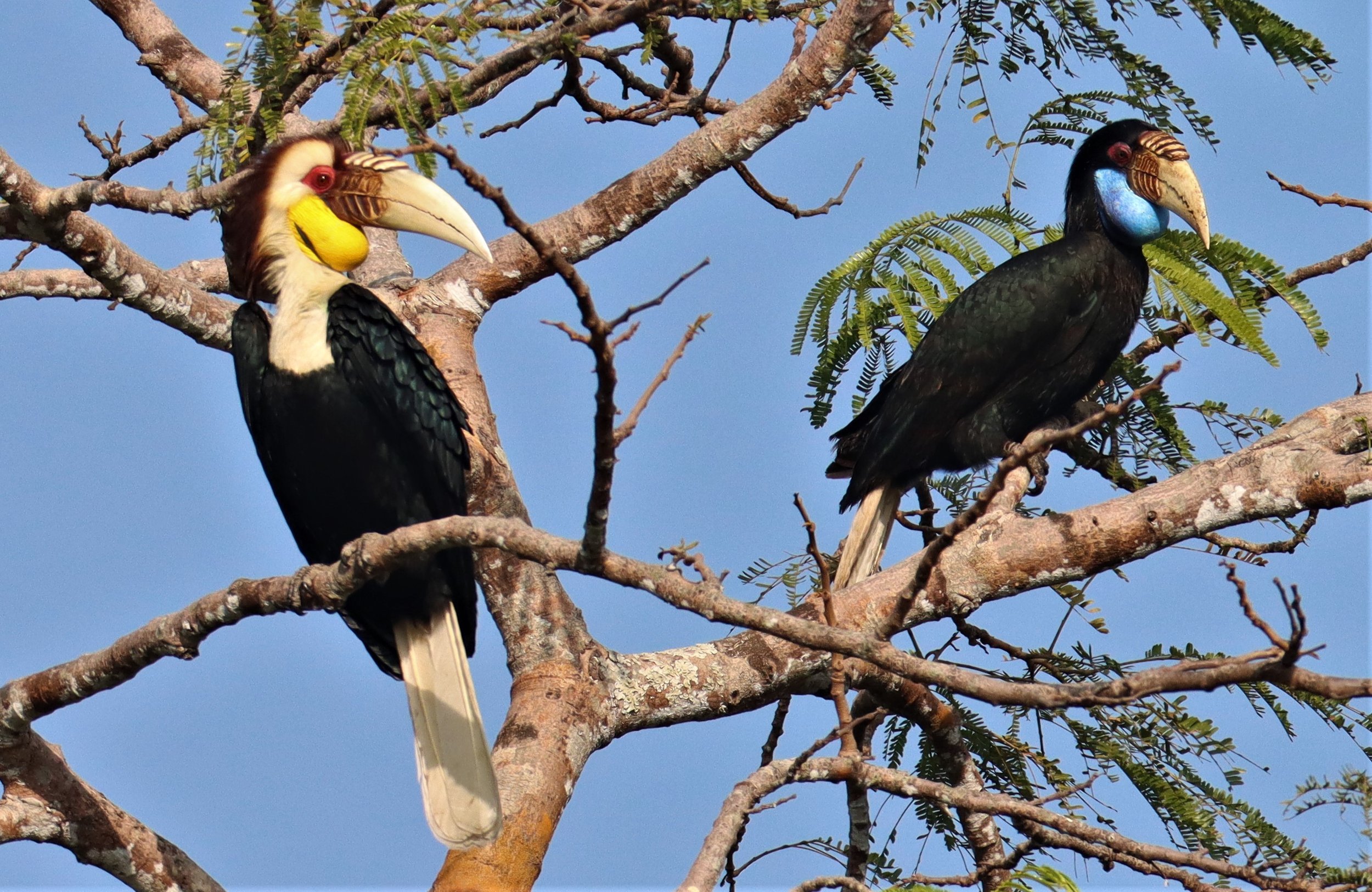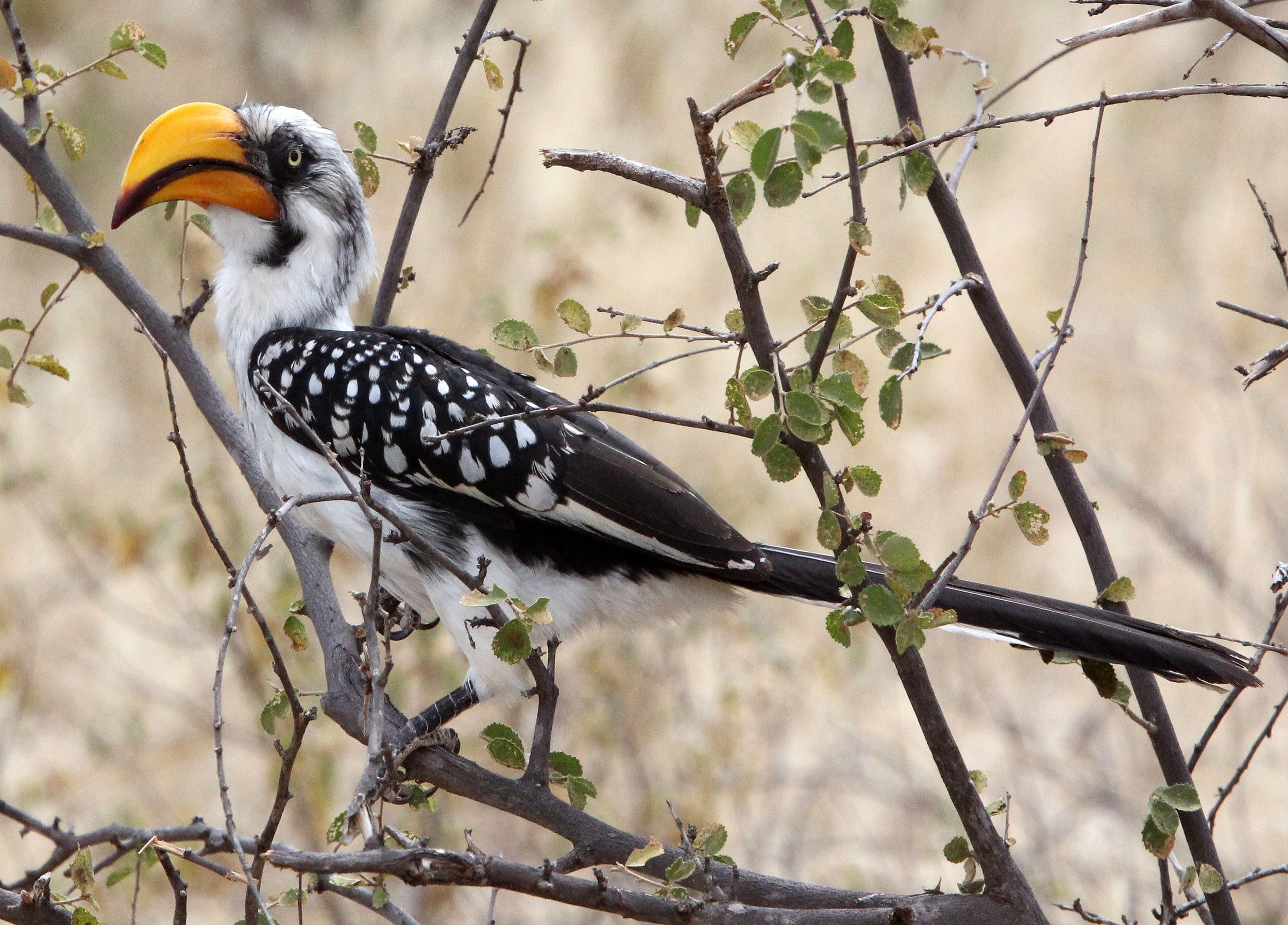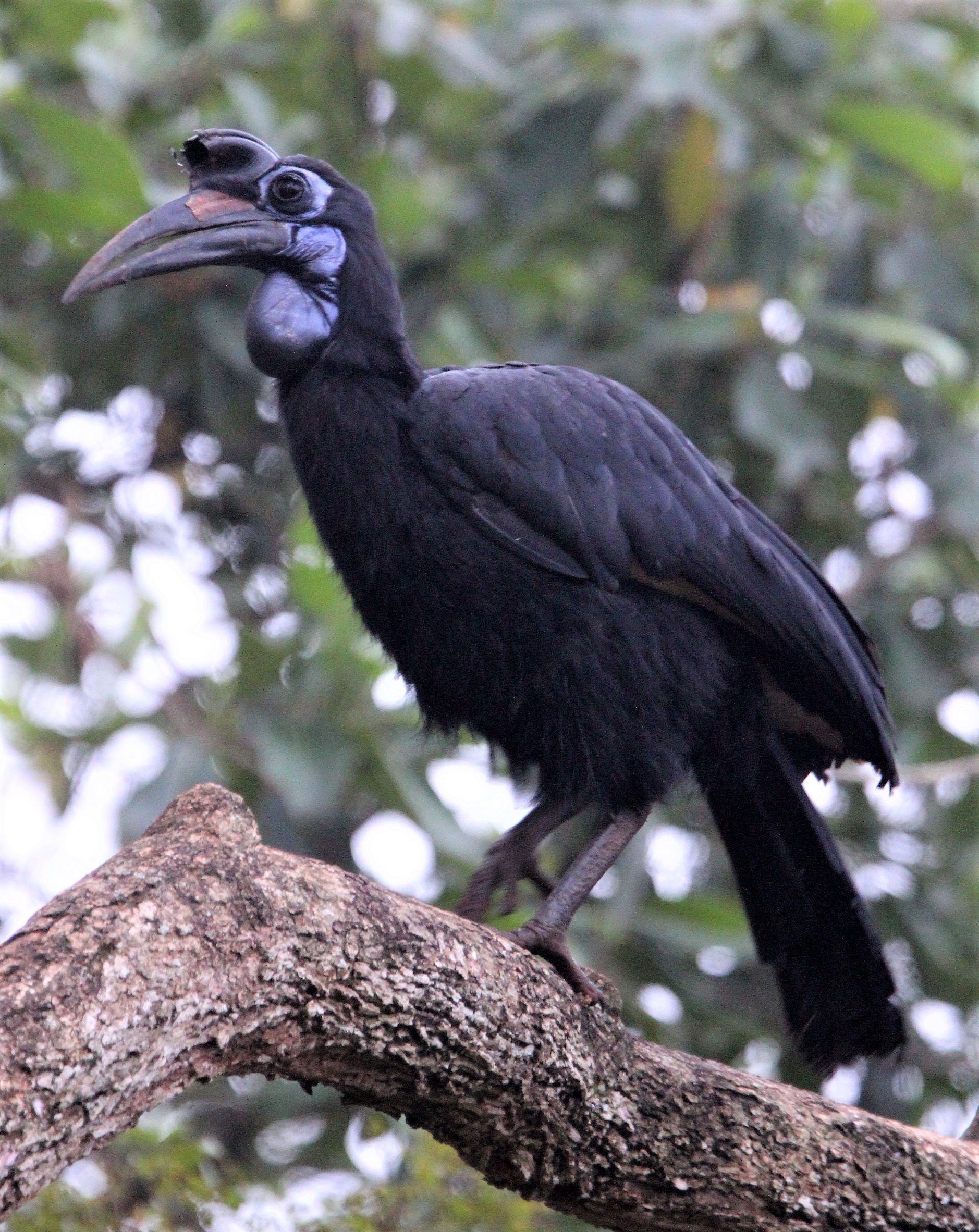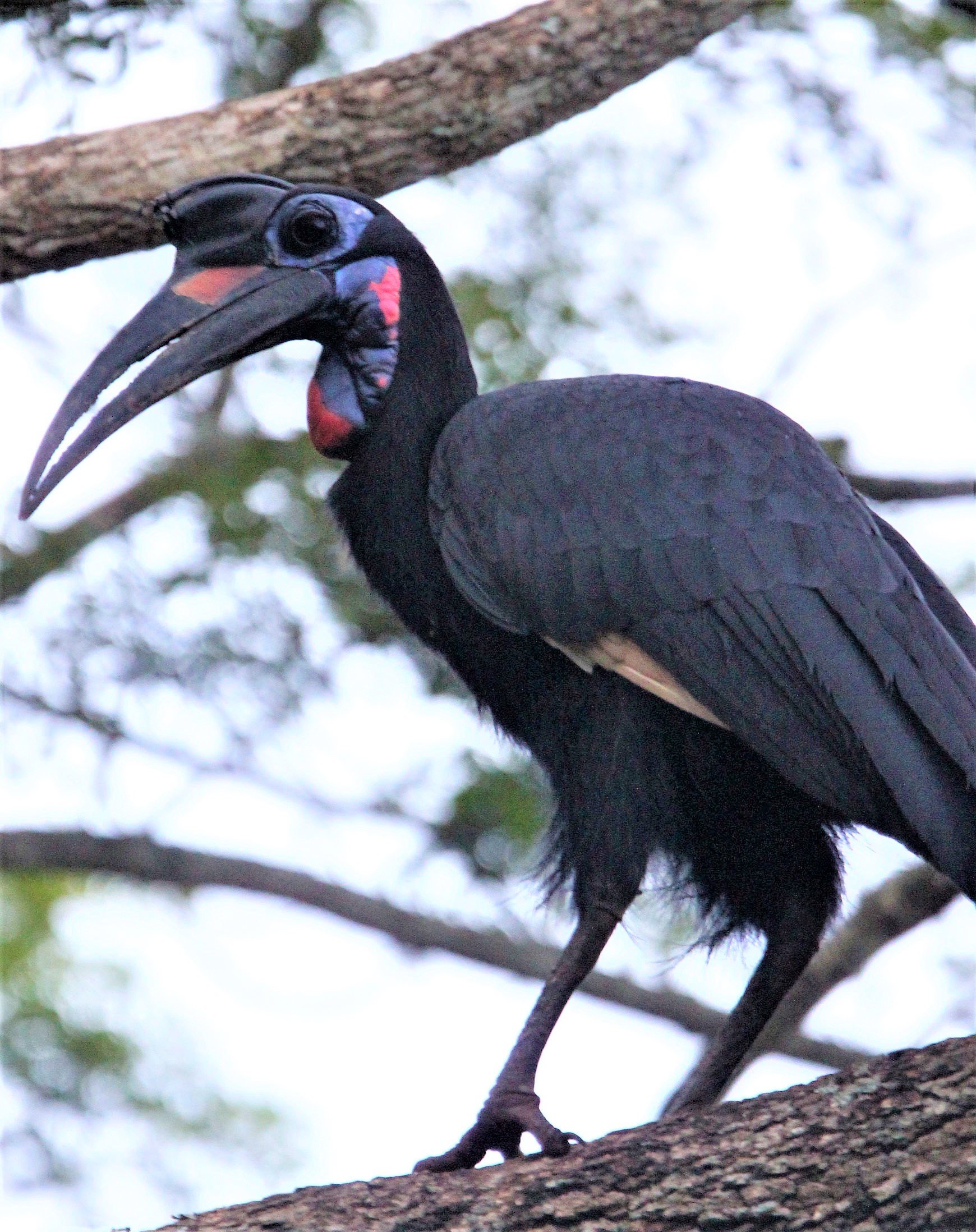
Hornbills

Sulawesi Wrinkled (Knobbed) Hornbill (Rhyticeros cassidix) seen in Tangkoko, Sulawesi, Indonesia. Male
Hornbills (Bucerotidae) are a family of bird found in tropical and subtropical Africa, Asia and Melanesia. They are characterized by a long, down-curved bill which is frequently brightly coloured and sometimes has a casque on the upper mandible. Both the common English and the scientific name of the family refer to the shape of the bill, "buceros" being "cow horn" in Greek. Hornbills have a two-lobed kidney. They are the only birds in which the first and second neck vertebrae (the atlas and axis respectively) are fused together; this probably provides a more stable platform for carrying the bill. The family is omnivorous, feeding on fruit and small animals. They are monogamous breeders nesting in natural cavities in trees and sometimes cliffs. A number of mainly insular species of hornbill with small ranges are threatened with extinction, namely in Southeast Asia.
In the Neotropical realm, toucans occupy the hornbills' ecological niche, an example of convergent evolution. Despite their close appearances, the two groups are not related, with toucans being allied with the woodpeckers, honeyguides and several families of barbet, while hornbills (and their close relatives the ground hornbills) are allied with the hoopoes and wood-hoopoes.
Sri Lanka Grey Hornbill (Ocyceros gingalensis) is an endemic species to Sri Lanka
The Bucerotidae include about 55 living species, though a number of cryptic species may yet be split, as has been suggested for the red-billed hornbill. Their distribution includes Sub-Saharan Africa and the Indian subcontinent to the Philippines and the Solomon Islands, but no genus is found in both Africa and Asia. Most are arboreal birds, but the large ground hornbills (Bucorvus), as their name implies, are terrestrial birds of open savanna. Of the 24 species found in Africa, 13 are birds of the more open woodlands and savanna, and some occur even in highly arid environments; the remaining species are found in dense forests. This contrasts with Asia, where a single species occurs in open savanna and the remainder are forest species. The Indian subcontinent has 10 species of hornbills, of which 9 are found in India and adjoining countries, while the Sri Lanka grey hornbill is restricted to the island. The most common widespread species in the Indian subcontinent is the Indian grey hornbill. According to the International Union for Conservation of Nature (IUCN), Indonesia has 13 hornbill species: 9 of them exist in Sumatra, and the rest exist in Sumba, Sulawesi, Papua and Kalimantan. Kalimantan has the same hornbill species as Sumatra, except that the great hornbill is not found there. In the Neogene (at least in the late Miocene), hornbills inhabited North Africa and South Europe. Their remains have been found in Morocco and Bulgaria. The oldest known hornbill is from the Early Miocene of Uganda, around 19 million years ago, which is similar to modern Tockus.
None of the African species of hornbills are seriously threatened, but many Asian hornbills are threatened by hunting and habitat loss, as they tend to require primary forest. Among these threatened species, only the plain-pouched hornbill and rufous-necked hornbill are found on the Asian mainland; all others are insular in their distribution. In the Philippines alone, one species (the Palawan hornbill) is vulnerable, and two species (the Mindoro and Visayan hornbills) are endangered. Two of the three critically endangered hornbills, the rufous-headed hornbill and the Sulu hornbill, are also restricted to the Philippines. The latter species is one of the world's rarest birds, with only 20 breeding pairs or 40 mature individuals, and faces imminent extinction. The Ticao hornbill, a subspecies of the Visayan hornbill, is probably already extinct. The other critically endangered species, the helmeted hornbill, is threatened by uncontrolled hunting and the trade in hornbill ivory.
This gallery has links to all of the species I have seen and documented over the years. I have seen at least 35 of the 55 extant species of hornbills in my travels and have images of 31. To see the galleries with a complete collection of my images for each species, simply follow the links on the below images.
Follow links on the images below to see galleries with a complete collection of images for each species pictured
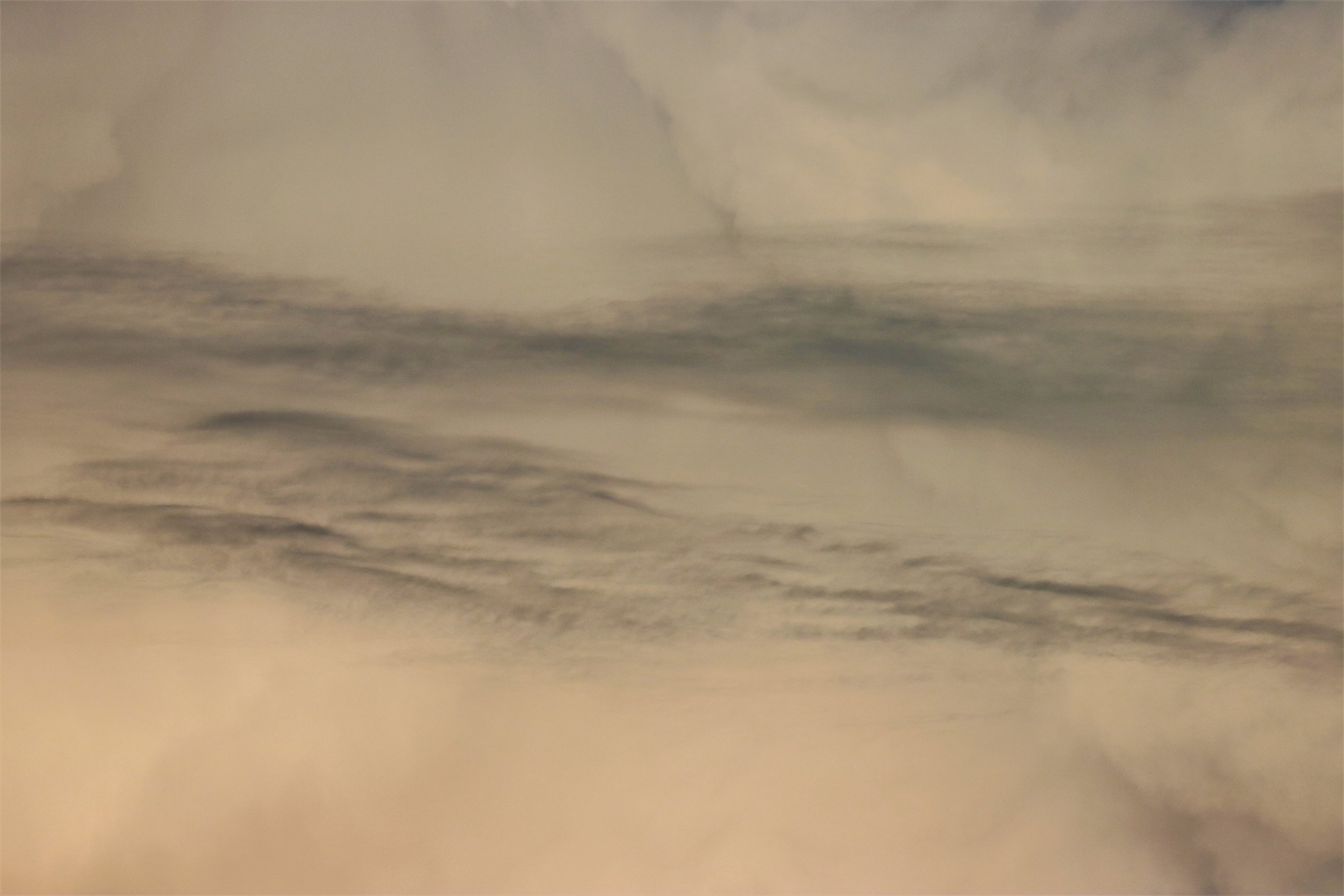
Great Hornbill (Buceros bicornis) Khao Yai National Park, Thailand
Rhinoceros Hornbill (Buceros rhinoceros) Hala Bala Wildlife Reserve, Thailand
Sulawesi Wrinkled (Knobbed) Hornbill (Rhyticeros cassidix) Nantu National Nature Reserve, Sulawesi, Indonesia (Male-female pair)
Wrinkled Hornbill (Rhabdotorrhinus corrugatus) Kinabatangan River, Sabah, Malaysian Borneo
Wreathed Hornbill (Rhyticeros undulatus) Khao Yai National Park, Thailand

White-crowned Hornbill (Berenicornis comatus) Krung Ching Camp, Khao Luang National Park, Nakhonsithammarat, Thailand. Male-female breeding pair.
Black & White Casqued Hornbill (Bycanistes subcylindricus) Entebbe Botanical Gardens, Uganda
Black-casqued Wattled Hornbill (Ceratogymna atrata) Dzangha Ndoki National Park, Central African Republic
Silvery-cheeked Hornbill (Bycanistes brevis) Lake Awassa, Ethiopia
White-thighed Hornbill (Bycanistes albotibialis) Dzangha Ndoki National Park, Central African Republica

Bushy-crested Hornbill (Anorrhinus galeritus) Gamontong Cave, Sabah, Malaysian Borneo
Austen’s Brown Hornbill (Anorrhinus austeni) Khao Yai National Park, Thailand

Monteiro’s Hornbill (Tockus monteiri) Damaraland, Namibia
Red-billed Hornbill (Tockus erythrorhynchus) Shaba Reserve, Kenya
Von Der Decken’s Hornbill (Tockus deckeni) Abiata-Shalla National Park, Ethiopia
Hemprich’s Hornbill (Lophoceros hemprichii) Lake Langano, Ethiopia
Southern Yellow-billed Hornbill (Tockus leucomelas) Kruger National Park, South Africa
African Grey Hornbill (Lophoceros nasutus) Murchison Falls National Park, Uganda
Southern Red-billed Hornbill (Tockus rufirostris) Saint Lucia Nature Reserve, South Africa
Crowned Hornbill (Lophoceros alboterminatus) Chobe National Park, Botswana
Bradfield’s Hornbill (Tockus bradfieldi) Damaraland, Namibia
Eastern Yellow-billed Hornbill (Tockus flavirostris) Shaba Reserve, Kenya

Sri Lanka Grey Hornbill (Ocyceros gingalensis) Kitulgala National Forest Reserve, Sri Lanka
Malabar Grey Hornbill (Ocyceros griseus) Indira Gandhi Topslip National Park, Tamil Nadu, India
Indian Grey Hornbill (Ocyceros birostris) Bandhavgar National Park, India

Malabar Pied Hornbill (Anthracoceros coronatus) Yala National Park, Sri Lanka
Black Hornbill (Anthracoceros malayanus) Kinabatangan River, Malaysian Borneo
Oriental Pied Hornbill (Anthracoceros albirostris) Khao Yai National Park, Thailand

Abyssinian Ground Hornbill (Bucorvus abyssinicus) Langano Lake Ethiopia, Male-Female pair
Southern Ground Hornbill (Bucorvus leadbeateri), Kruger National Park South Africa







